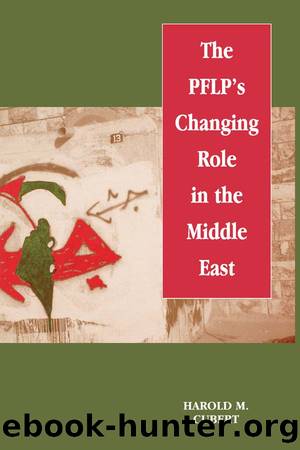The PFLP's Changing Role in the Middle East by Harold M. Cubert

Author:Harold M. Cubert [Cubert, Harold M.]
Language: eng
Format: epub
Tags: History, Middle East, General, Social Science, Regional Studies
ISBN: 9781135220297
Google: 8ku4AwAAQBAJ
Publisher: Routledge
Published: 2014-06-03T17:14:30+00:00
ORGANIZATIONAL LEVELS
The PFLP's organizational subdivisions are organized both geographically and functionally. They may pertain either to a geographic area or an area of responsibility (the external branch, for example, handles the PFLP's foreign operations). The PFLP's base organizations are circles and cells, which meet at members' homes or workplaces. These, in turn, are grouped into leagues, districts, regions, and branches. Thereafter, the PFLP is organized at what it calls the ânational levelâ, where the top leadership makes its decisions through the national congress, the central committee, and the politburo (article 25(1)).
The national congress is the PFLP's supreme governing body. The PFLP central committee is the PFLP's highest authority between sessions of the national congress, and the PFLP politburo is its highest authority between central committee sessions (article 25(2)(a)). The PFLP similarly operates at the branch, regional, and district levels. The congresses at these levels are called supervisory congresses, and supervisory commands govern the organization between congress sessions (article 25(2)(b)).
Theoretically, PFLP members choose their leaders through free elections (article 25(3)). They vote for candidates by secret ballot and are permitted to criticize the candidates' positions (article 25(4)). The PFLP holds its elections according to the principles of âdemocratic centralismâ. In terms of elections, this means that although voting occurs at the base level, the national congress must approve the candidate lists. It may even remove the names of candidates it does not like. Should the national congress reject the entire candidate list, it may nominate its own. The national congress may also censor the candidate lists at the supervisory levels (article 25(5)).
At the central committee and politburo levels, a certain percentage of the members are automatically âre-electedâ, thereby satisfying the âcontinuityâ principle (article 25(6)). The PFLP also permits interim elections under certain circumstances, but, the Internal Rules do not specify what those circumstances are (article 25(7)).
Download
This site does not store any files on its server. We only index and link to content provided by other sites. Please contact the content providers to delete copyright contents if any and email us, we'll remove relevant links or contents immediately.
The PFLP's Changing Role in the Middle East by Harold M. Cubert(135)
100 myths about the Middle East by Fred Halliday(126)
Revolution Without Revolutionaries by Bayat Asef(104)
US Nation-Building in Afghanistan by Conor Keane(99)
The Emergence of the Gulf States by J. E. Peterson(90)
Islam, Nationalism and Communism in a Traditional Society by Gabriel Warburg(80)
A Grammar of Ugaritic by John Screnock; Vladimir Olivero(75)
All the World Is Awry by R. Kevin Lacey(60)
The Islamic Polity and Political Leadership: Fundamentalism, Sectarianism, and Pragmatism by Mehran Tamadonfar(59)
Islam, Nationalism and Communism in a Traditional Society: The Case of Sudan by Gabriel Warburg(44)
Islamic Law in Circulation by Mahmood Kooria;(44)
Amazigh Politics in the Wake of the Arab Spring by Bruce Maddy-Weitzman(28)
